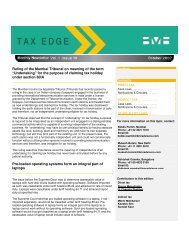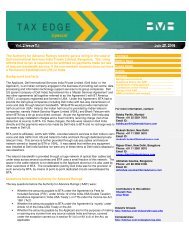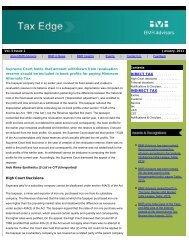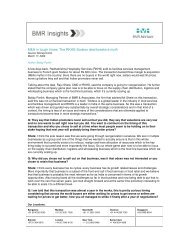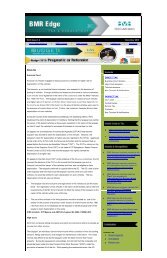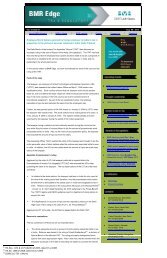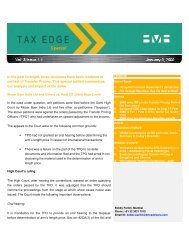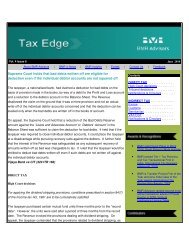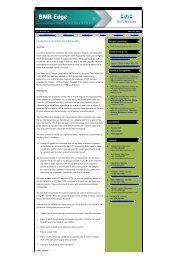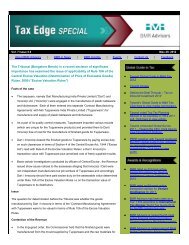Corporate Tax 2010 - BMR Advisors
Corporate Tax 2010 - BMR Advisors
Corporate Tax 2010 - BMR Advisors
You also want an ePaper? Increase the reach of your titles
YUMPU automatically turns print PDFs into web optimized ePapers that Google loves.
Accura Advokataktieselskab<br />
Denmark<br />
3.5 If so, is there a “safe harbour” by reference to which tax<br />
relief is assured<br />
The 4:1 ratio in connection with thin capitalisation is a safe harbour,<br />
i.e. interest above the 4:1 ratio can be deducted if it can be<br />
substantiated that a similar loan could have been obtained (on<br />
market terms) from an independent third party without any security<br />
from a related party. Furthermore, the thin capitalisation rules only<br />
apply if the controlled debt exceeds DKK 10 million at year-end.<br />
3.6 Would any such “thin capitalisation” rules extend to debt<br />
advanced by a third party but guaranteed by a parent<br />
company<br />
Yes. Third party debt will be deemed to be related-party debt if<br />
such debt is guaranteed by a party related to the Danish borrowing<br />
company.<br />
(3) prepare and keep on file written documentation to justify<br />
whether the prices in terms of their intergroup transactions<br />
are on an arm’s length basis.<br />
Danish transfer pricing legislation does not specify any methods for<br />
determination of arm’s length prices. This means that the method<br />
described in the OECD transfer pricing guidelines should be<br />
followed. OECD has given priority to the traditional transaction<br />
based methods. Accordingly, the Danish guidelines also recognise<br />
the following transfer pricing methods listed in order of priority:<br />
comparable uncontrolled price methods;<br />
resale price method;<br />
cost plus method;<br />
profit split method; and<br />
transactional net margin methods.<br />
4 <strong>Tax</strong> on Business Operations: General<br />
Denmark<br />
3.7 Are there any restrictions on tax relief for interest<br />
payments by a local company to a non-resident in addition<br />
to any thin capitalisation rules mentioned in questions<br />
3.4-3.6 above<br />
4.1 What is the headline rate of tax on corporate profits<br />
The corporate tax rate is 25%.<br />
In addition to the thin capitalisation rules the following two tests<br />
have to be made to determine the actual level of deductibility of<br />
interest payments:<br />
1. “interest ceiling” test; and<br />
2. the “EBIT model” test.<br />
These tests only apply if net financing costs exceed DKK 21.3<br />
million in 2009 (adjusted annually, i.e. currently approximately<br />
EUR 3 million) per fiscal year. In the case of two (or more)<br />
affiliated Danish companies, the amount of DKK 21.3 million<br />
applies to the aggregate net financing costs of the affiliated<br />
companies (i.e. the tests apply if the companies’ aggregate net<br />
financing costs exceed DKK 21.3 million).<br />
If the net financing costs exceed DKK 21.3 million per year, there<br />
will be an interest cap limiting the tax deductibility of any net<br />
financing cost exceeding the taxable value of the qualifying<br />
company’s (or jointly taxed companies’) assets at year-end<br />
multiplied by a standard interest rate (in 2009, 6.5%). The part of<br />
the net financing costs that are in excess of the interest cap are lost<br />
and cannot be carried forward.<br />
The EBIT rule applies alongside the above interest cap rule. Even if<br />
the interest ceiling test (6.5% test) is met, net financing costs can<br />
only reduce taxable income with 80% of taxable EBIT (earnings<br />
before interest and taxes). Any excess net financing cost can be<br />
carried forward to reduce taxable EBIT in subsequent years.<br />
Please note that only net financing costs exceeding DKK 21.3<br />
million (2009) will be capped.<br />
4.2 When is that tax generally payable<br />
The tax is payable on account in two equal instalments no later than<br />
20 March and 20 November in the income year.<br />
A Danish company must file an income tax return annually. A tax<br />
assessment is issued after the tax return has been filed. The tax<br />
assessment shows the assessed taxable income and the tax payable.<br />
If the final tax liability exceeds the tax payments made, a surcharge<br />
of 6.1% (2009) of the outstanding tax liability will be payable.<br />
4.3 What is the tax base for that tax (profits pursuant to<br />
commercial accounts subject to adjustments; other tax<br />
base)<br />
In Denmark, the tax base follows the commercial account subject to<br />
adjustments.<br />
4.4 If it otherwise differs from the profit shown in commercial<br />
accounts, what are the main other differences<br />
Normally, depreciation for tax purposes differs from depreciation<br />
for accounting purposes. In general, the depreciation for tax<br />
purposes exceeds the depreciation permitted in connection with<br />
commercial accounts. Depreciation for accounting purposes must<br />
use the real value of the assets which does not apply to depreciation<br />
for tax purposes.<br />
3.8 Does Denmark have transfer pricing rules<br />
Yes. Danish transfer pricing legislation follows the OECD transfer<br />
pricing guidelines, and the rules apply to Danish companies with<br />
both cross-border related party transactions and national<br />
transactions.<br />
In summary, the transfer pricing legislation implies that Danish tax<br />
payers subject to the rules must:<br />
(1) apply the arm’s-length principle when determining<br />
intergroup prices;<br />
(2) provide information on the nature and the extent of<br />
intergroup transactions in their tax return; and<br />
ICLG TO: CORPORATE TAX <strong>2010</strong><br />
© Published and reproduced with kind permission by Global Legal Group Ltd, London<br />
4.5 Are there any tax grouping rules Do these allow for relief<br />
in Denmark for losses of overseas subsidiaries<br />
Mandatory Danish joint taxation<br />
Denmark has mandatory joint taxation for affiliated companies<br />
(controlling interest) which are domiciled in Denmark.<br />
Under Danish law, any permanent place of operation or real estate<br />
located in Denmark, which is owned by a company not taxable in<br />
Denmark, is jointly taxed with all its affiliated companies in<br />
Denmark.<br />
Optional international joint taxation<br />
International joint taxation is not mandatory but can be elected. If<br />
71<br />
WWW.ICLG.CO.UK







